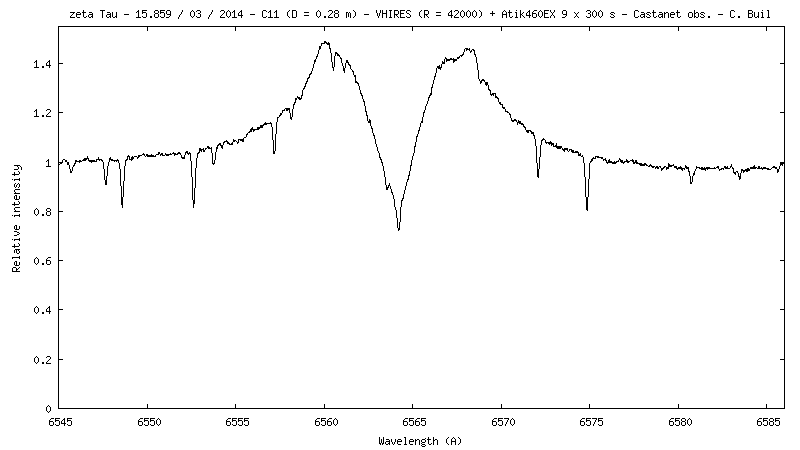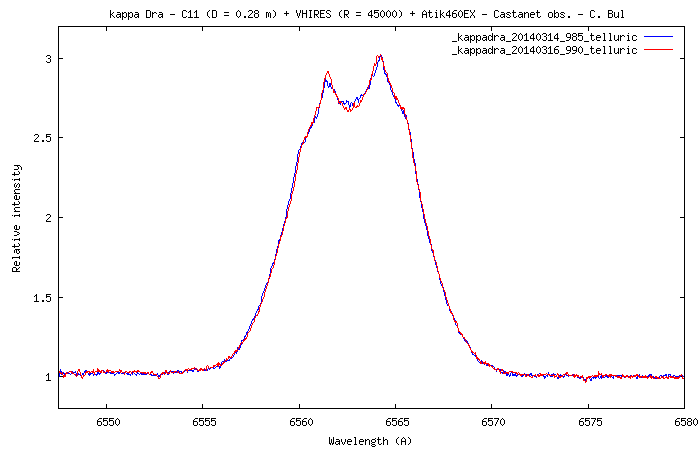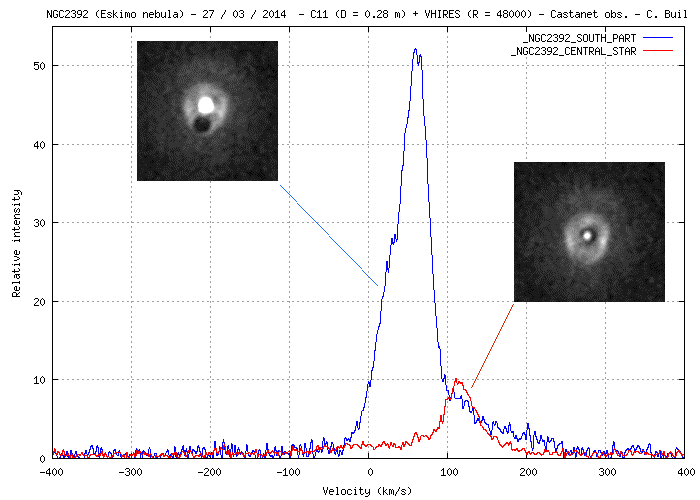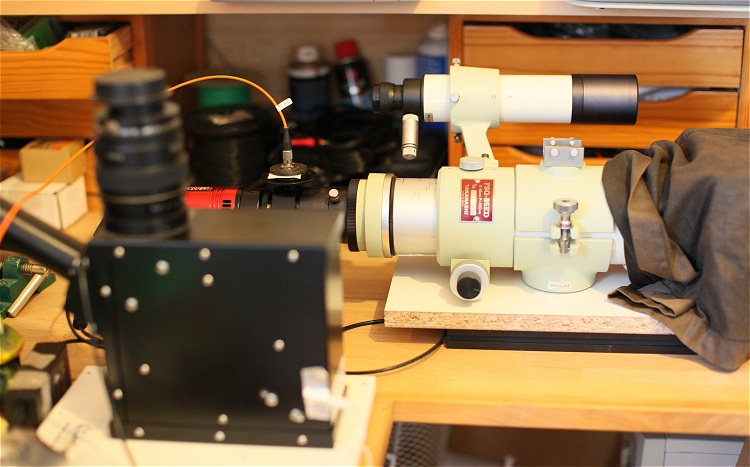VHIRES
Very HIgh REsolution Spectrograph
First light of a prototype
This page describe conception of a very high spectral resolution spectrograph. The target resolution is around R=48000 (i.e. FWHM line shape of 0,14 A or 6 km/s @ 6563 A).
The definition, construction and adjustment took only 3 hours (during the day of March 14 - in "emergency" mode because the next night is announced without clouds !). No machining, but top performances components. Unfortunately also a very expensive intrument in this maximal version (use of one of the better aprochromatic optic available on the market, a very large diffractive grating costing about 6000 euros at unity command, ...). A more modest resolution specification (R=30000) can down significatly this prices.The grating is here an échelle Richardson model. Blank size: 220 x 110 x 30 mm. The graving density is 110 grooves / mm and the blaze angle of 64.5°. This component is selected because Halpha is precisely at the center of blaze function for order k = 25 (k = 25.01 to be precise). Efficiency is maximized.
A Takahashi refractor FSQ85ED (a fine apochromatic astrograph) is used in autocollimation mode. The aperture diameter is 85 mm and focal length 450 mm.
A Atik Off-Axis Guider model is used to inject stellar flux into the refracror coming from a 50 microns optical fiber (from the guiding port).
An excellent Astrodon Halpha filter (5 angstroms pass-band) is mounted just in front of the CCD camera for select order #25 (no cross disperser used, the goal is maximal simplification to observe with some details in immediate vicinity of Halpha line only - like a fix super Lhires III spectrograph).
The camera is an Atik460EX operated in binning 3x3 (equivalent pixels size, 13.62 microns). The spectral covered domain is of 42 angstroms (only, but remenber the very high resolution). The spectral sampling is 0,0462 A/pixel (bin 3 mode).
At the telescope level, the object is guided and the flux injected in the 50 microns fiber by using the eShel interface (Shelyak Instruments).
The system is simple, but there is no concession: large aperture elements, high optical quality ... The optical diagram of VHIRES:
Here some view of the VERY (!) preliminary setup:




The maner to maintain the grating is really improvised (prototype phase) ! I do not have time to do anything else. Note the method for adjust inclinaison of the refractor, hum...
Here, the definitive version on a very rigid optical bench... (click here for more details) :

The telescope interface :


Typical
VHIRES spectrum during acquisition (Audela sotfware). The 2D spectrum
trace is very sharp.
Below, the spectrum of a part M42 nebulae. Of course, the Halpha line (HI) is nearly at the center. Note the separation of [NII] lines. The shape of the emission lines is real: asymmetric profile and enlargement are associated to gas velocity field in the nebula.

The proof, look the aspect of pure monochromatic lines from the Thorium-Argon calibration lamp of eShel spectrograph and compare with M42 lines. The measured FWHM of ThorAr emission lines give à resolution power of R = 48000, exactly the theoretical value:

Two example of A type star spectra with a well marked Voigt profile (Sirius and Vega). The Halpha wing line extand out of CCD field (a more largest detector format can be selected). Note the difference of HI line position relative to H2O telluric lines motif:


Spectrum of Moon surface (i.e. Solar spectrum, a G2V star). The Halpha profile is well detailled. The H2O telluric lines begin to be also resolved:

A coolest star, Arcturus (alpha Boo) - type K1.5III. Note symetry of Halpha and sharp Fe lines:

More largest metallic lines are noted on Betelgeuse spectrum (M2Iab):

Some Be stars, here Shelyak (beta Lyrae):

delta Scorpius:

zeta Tau (note details in the emission line, probably fast time evolving):

kappa Dra (note the diversity of Halpha profile from Be star to another):

A spectroscopic binary star (Mizar in Ursa Major):

The famous P-Cygnii star (34 Cyg):

The actual aspect of Halpha profile in epsilon Aurigae system:

And some active stars. For example the supergiant Rigel (beta Ori):

alpha Auriga (Capella is not a quiest world, look the distorded aspect of Halpha profile):

and the lastest object of this first light session with VHIRES, Deneb:

Complements
Fast time evolution (two days) on Rigel and kappa Dra (telluric lines are removed for clarity) :


Deneb (alpha Cyg) is also a variable star... (modification of Halpha profile from March 15 to March 20, 2014:

Doppler shift between two fast rotator (Altair and Regulus - note the very wide Halpha profile). The Doppler-Fizeau shift is caused by proper radial velocities of the stars and heliocentric velocity of Earth (of course, position of H2O telluric lines is inchanged between the two spectra):

Magnitude test on some Be stars (cick on the image for enlarge):
For astrophysical analysis, a reasonable signal to noise ratio of 50 for the red continuum is reached with a 28 centimeters telescope on V = 6.0 stars in a one hours exposure (stack of 12 x 300 sec. frames). For the same results, the corresponding magnitudes for a 40 and a 60 cm telescope is evaluated to V = 6.6 and V = 7.3 respectively.
And now... a key of the setup: the capacity to modified the wavelength range by changing only the bandbass filter. Here I have replacing the Astrodon Halpha 5 nm filter, with an Astronomik Hbeta filter (+ a Baader IR cutoff filter). The FWHM of this filter, 14 nm, is just the free spectral interval for the diffraction ordrer #34, nearly centered on hydrogen Hbeta line. Of course, the resolution is still R = 48000 (the constancy of the spectral resolution is a characteristic of échelle spectrograph).
Here the Hbeta region on some bright stars (click on the image for enlarge):
Observations of yellow sodium doublet near 5890 A. The corresponding diffraction order is selected by an Edmund Optics Barrington bandpass filter centred on wavelength 589 nm with a FWHM of 10 nm (24 mm diameter). Example on Capella and Pollux stars (note presence of stellar + interstellar Na lines doublet, wavelength shifted):


Here, a very special observation mode. The spectral resolution is pushed to R = 83000 (delta lambda = 0,071 A) ! For this, the 50 microns diameter optical fibed image is binned only on the upper and lower alon three lines (3 x 6.45 = 19.35 microns width bin).

Aspect of a part of Thorium-Argon 2D spectrum. Note the very apparent fiber diameter (6.45 microns pixel sample).

Principle of
spectral resolution improvement.

Demonstration
of method efficiency for increase spectral resolution (but of course,
the signal to noise is reduced - the operation is a typical transfert
of information from radiometrc resolution to spectral resolution).
The inset image is a real image of the optical fiber on the detecteur
plane. Click on the image for enlarge.
High velocity flow in planetary nebula NGC2392 (for two positions of optical fiber, at the level of southern brightness part (blue curve), at the level of central star (red curve)). The spectrum, showing Halpha line, is given in velocity unit and the Earth heliocentric velocity is corrected:

The "final" VHIRES experience setup (March 19, 2014):




In the first
plane, the eShel spectrograph - a classical echelle spectrographe
from Shelyak Instruments, in the second
plane the VHIRES spectrograph
prototype (with a resolving power 4.4 times
superior for this later, but
also with
a much narrower spectral
coverage,
the sanction of a "simplified" setup, i.e. no cross-disperser).
See here a page on VHIRES solar surface observations
Click here for more demo (RR Lyrae time resolution, Doppler effect on Saturn planet, ...
Transform VHIRES to an echelle spectrograph with cross-diserser, click here

